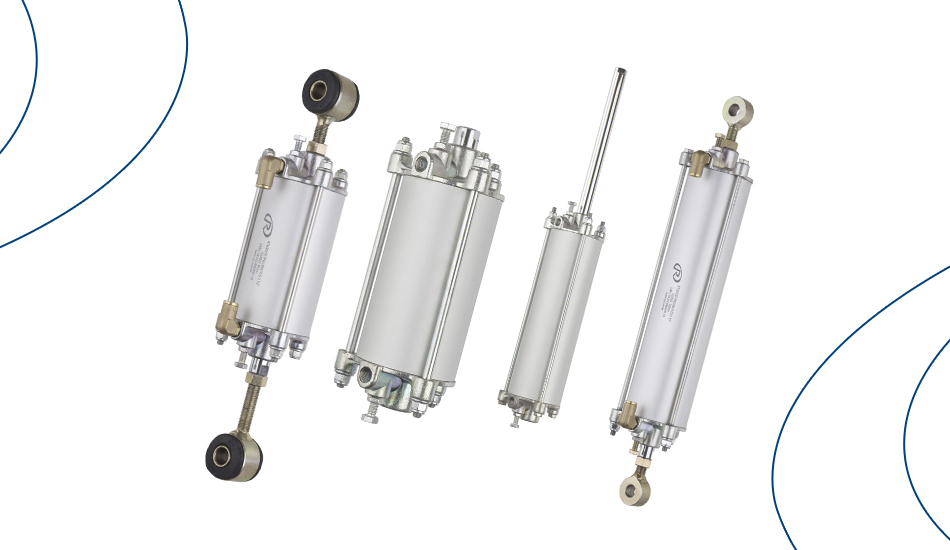In industrial automation, the precision and efficiency of processes ensure productivity and safety. Among the various components that make this possible, the pneumatic actuator stands out as one of the main devices responsible for transforming energy into motion, being widely used in machine control and automation systems.
Whether in the automotive, agricultural, or industrial applications sectors, pneumatic actuators play a fundamental role in executing tasks that require force, speed, and precision. In this article, we will explore how these devices work, the different types available, and their main applications.
What is a pneumatic actuator?
A pneumatic actuator is a device that converts compressed air energy into mechanical motion. This motion can be linear (back and forth) or rotary (circular), depending on the type of actuator and the specific application.
Pneumatic actuators are widely used in industry due to their simplicity, reliability, and ability to generate considerable forces with rapid response. Additionally, they are ideal for environments where safety is paramount, as they do not generate sparks or require electricity at the point of operation.
How does a pneumatic actuator work?
The operation of a pneumatic actuator is based on simple yet effective physical principles. The basic process includes:
Compressed air supply: Air is compressed by a compressor and stored in a reservoir or distributed directly through a pneumatic network.
Flow control: Directional valves control the air flow to the actuator, determining the direction and timing of movement.
Energy conversion: Inside the actuator, compressed air exerts pressure on a piston (in linear actuators) or vanes (in rotary actuators), generating motion.
Return: The return movement can be performed by a spring (single-acting actuators) or by compressed air in the opposite direction (double-acting actuators).
Types of pneumatic actuators
There are various types of pneumatic actuators, each designed for specific applications:
1. Linear actuators (pneumatic cylinders)
Single-acting cylinders: Use compressed air for movement in one direction and spring for return
Double-acting cylinders: Use compressed air for movement in both directions
Rodless cylinders: Ideal for confined spaces
Telescopic cylinders: Provide long stroke in compact space
2. Rotary actuators
Rack and pinion actuators: Convert linear motion to rotary
Vane actuators: Use vanes that rotate within a chamber
Helical screw actuators: Offer high torque with precise rotation
3. Special actuators
Pneumatic grippers: For holding and manipulation
Rotary tables: For precise angular positioning
Diaphragm actuators: For applications requiring high force with short stroke
Main applications in industrial automation
Pneumatic actuators find application in virtually all industrial sectors:
Automotive industry
Assembly lines for parts positioning
Robotic welding systems
Sheet metal forming presses
Automated painting systems
Food and pharmaceutical industry
Packaging and sealing systems
Dosing and filling machines
Conveyors and sorters
Sanitary valves for flow control
Packaging industry
Packaging machines
Palletizing systems
Sealers and labelers
Conveyors and diverters
Chemical and petrochemical industry
Process control valves
Safety and emergency systems
Mixers and agitators
Loading and unloading systems
Advantages of pneumatic actuators
Safety: Do not generate sparks, ideal for explosive environments
Simplicity: Robust design with few moving parts
Speed: Fast response and high-speed movements
Force: Ability to generate high forces
Cost: Generally more economical than electric or hydraulic alternatives
Maintenance: Require little maintenance
Cleanliness: No risk of oil leaks
Selection considerations
When choosing a pneumatic actuator, consider:
Required force: Calculate the necessary force considering load and safety factor
Operating speed: Determine the required cycle speed
Stroke: Define the distance the actuator must travel
Working environment: Consider temperature, humidity, and presence of contaminants
Frequency of use: Evaluate the number of cycles per minute or hour
Available space: Verify allowed physical dimensions
Required precision: Determine if precise position control is needed
Maintenance and care
To ensure longevity and optimal performance:
Proper filtration: Use air filters to remove contaminants
Lubrication: Maintain proper lubrication according to specifications
Regular inspection: Check seals, gaskets, and connections
Correct pressure: Operate within specified pressure limits
Cleaning: Keep components clean and free of debris
Conclusion
Pneumatic actuators are essential components in modern industrial automation, offering a unique combination of simplicity, reliability, and efficiency. By understanding their operating principles, available types, and applications, you can make informed decisions that optimize your production processes.
The correct choice of pneumatic actuator can make the difference between an efficient system and a problematic one. By considering factors such as type of motion, load capacity, resistance, and durability, you will be making a decision that directly impacts the efficiency, safety, and performance of your system.
RGR Pneumatic offers high-quality actuators designed to meet various needs, ensuring the reliability and performance of your pneumatic systems.
Our team of specialists is ready to help you choose the ideal pneumatic actuator for your application. Visit our website now and speak with our team!

